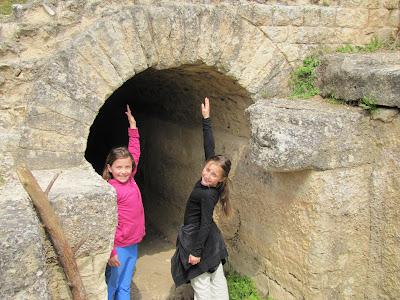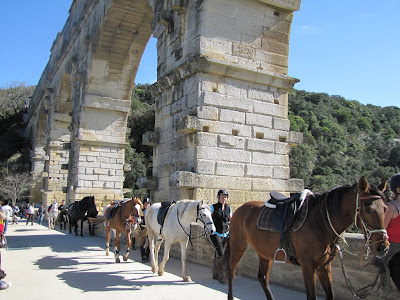A little Monty Python skit performed by Eleanore and Frances will give you a hint:
Introducing Pont du Gard...
It blew us Hamiltons away.
For me (Carolyn), I think it comes down to the stone. There's a breath you sense in stone.
I sensed it in Israel and I sensed it here.
This limestone is so, well, worn.
And it's thick and porous and golden, and against the blue sky it is just plain breathtaking.
And because it's not roped off, you can feel it.
I can't help but think that the warmth I feel is generated not so much by the sun, but by the people who stacked it thousands of years ago.
And maybe, it's something about optimism, too.
What blew Eleanore away was:
"Picturing all those people working on something so huge and so high above water, without any cranes or mortar.
That whole bridge is DRY STACKED!"
What blew Frances away was:
"Seeing two people kayaking under it with the wind going one way and the water going the other way."
The Pont du Gard spans the Gardon river.
We sat on its banks, under the pont and let our conversation drift. Not so surprising, in retrospect, that being in the presence of such serious art (architecture), inspired Frances to say she thought water might just be the most difficult thing in the world to paint.
What blew Jeff away was:
"The fact they could even build the thing. Not just this structure but the whole aqueduct system from Uzes. I didn't realize they had those surveying and engineering skills. It's so complicated. To be able to design and build a system over 50 K long with a consistent slope of 34cm per kilometer, that descends only 17 meters total from Uzes to Nimes. Amazing."
Here's the story of the Pont du Gard
Around 20 BC, Augustus's son-in-law, Marcus Agrippa decided to try to get clean water to the city of Nimes.
He found a source in our town, Uzes.
The water comes from a little spring ("Fontaines d'Eure) just up river from this photo.
The aqueduct travels south above and below ground.
This is part of the aqueduct. The girls play on it in the park every day.
Although Pont du Gard remains intact, most of the other portions of the aqueduct were pilphered for their stone in the last 1,000 years.
The Romans coated the aqueduct with mortar and the system delivered 5 million gallons of water to Nimes each day.
900 years later, the aqueduct was so calcified that the water couldn't flow anymore.
About 1,000 slaves, workers and engineers built the Pont du Gard in three years.
They built it arch by arch with wooden forms and scaffolding.
The rocks protruding from the arch acted as a brace for the scaffolding as they built it.
As Eleanore said, No mortar. Just perfectly cut and stacked limestone.
In the stone along the bridge are engravings.
One reads, "Frons Sinistra II," which means "Left Face 2."
It reminds us that these engineers had every part of the puzzle designed, cut and labled.
It also reminds us this was a public works project.
They weren't interested in aestethics but function
(ironic considering it's considered both a technical and artistic masterpiece and is a UNESCO World Heritage site).
Other engravings include phallic symbols to ward off bad luck.
We didn't see any.
At one point, the columns of the second level of the bridge were narrowed to allow foot traffic. This compromised the structure so in 1702, they restored the arches to their original size. Can you imagine a restoration project begun in 1701?
1.5 million people--and apparently horses--walk on this bridge each year.
In fact, anyone studying masonry in the last several hundred years has come here to admire and learn from this work.
The biggest stones weighed up to 6 tons.
The builders used human powered "squirrel cages"
to power pulley systems to lift and place the stones.
Jeff practiced his photographic masonry skills above,
placing each of our heads in an arch of our own.
We've gotten in the habit of saying what we're grateful for each day,
a ritual we attribute to our cousin Dominic.
Today, I am grateful for the relative absence of railings and ropes and chains separating historical monument from the general public in France.
We have been free to scamper around, cross over, peer through, sit on, climb on and press against so many fantastic historical prizes, most of which stand unattended, some of which stand unmarked entirely.
And this policy of keeping things accessible seems somehow to also keep alive the idea that time is a continuum and that each of us, child and adult, is connected to those who came before us; that each of us is capable of the great hopes and the great feats and even the great mistakes of those before us.
It keeps us optimistic and it keeps us humble.


















Hey you guys! I am soo happy to be able to finally read these blogs! It sounds like such a wonderful time and so amazing! I can't wait to see all of you guys again! Love you all!
ReplyDeleteAshley
Ashley Fralick if you didn't know
ReplyDeleteme too ashley. i am grommy. i am so grateful to be able to read and listen to these blogs. it saves me a trip to uzes. i know it well now and more each day. this trip today is really like going into a time machine. the weight of the project on the mind of the engineer and architect was enormous. do you suppose there were schools in 20 b.c. for this education? and of course, jeffrey, crowning your girls in arches was an attempt to canonize them, i suppose. what up for today?
ReplyDelete